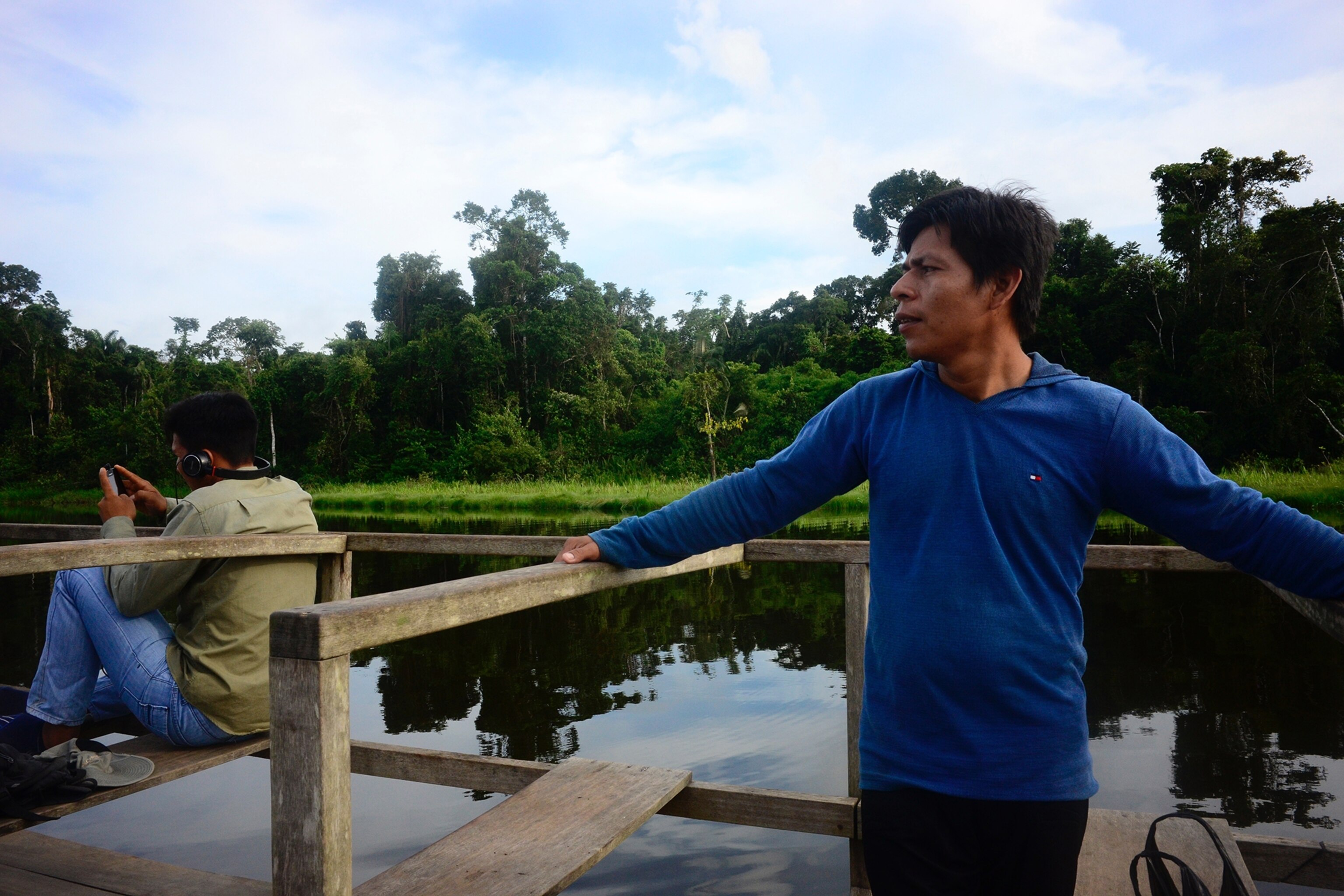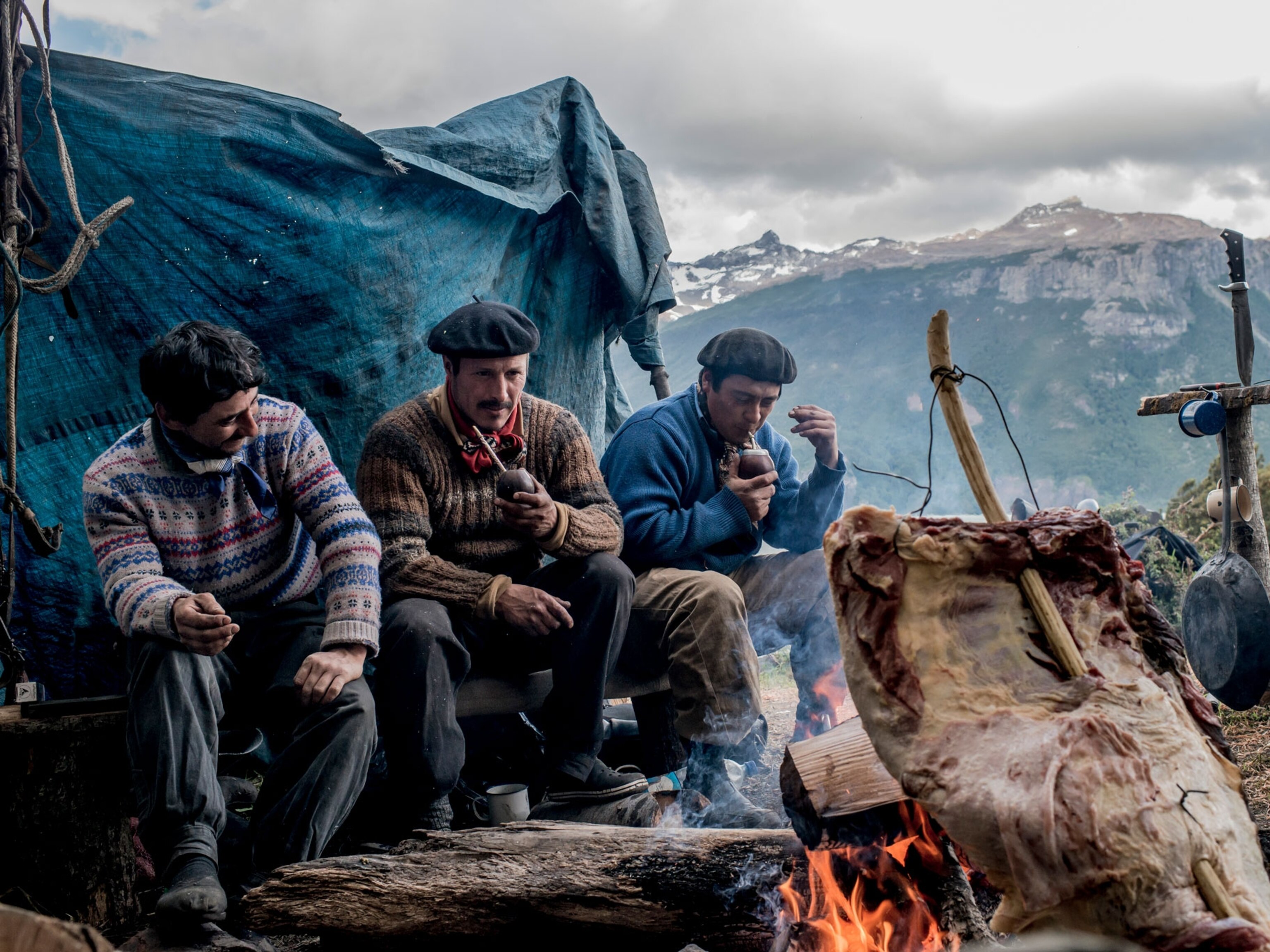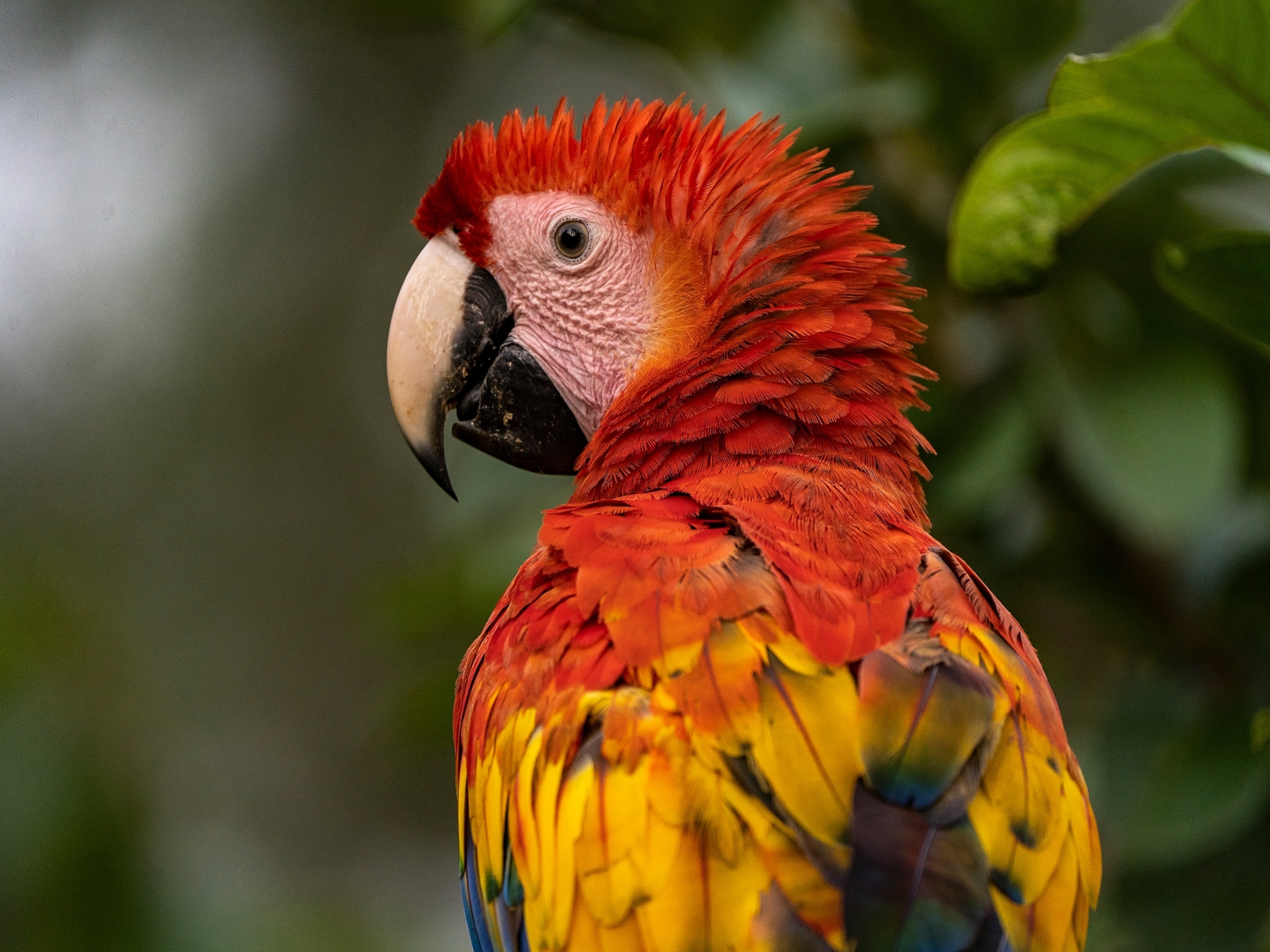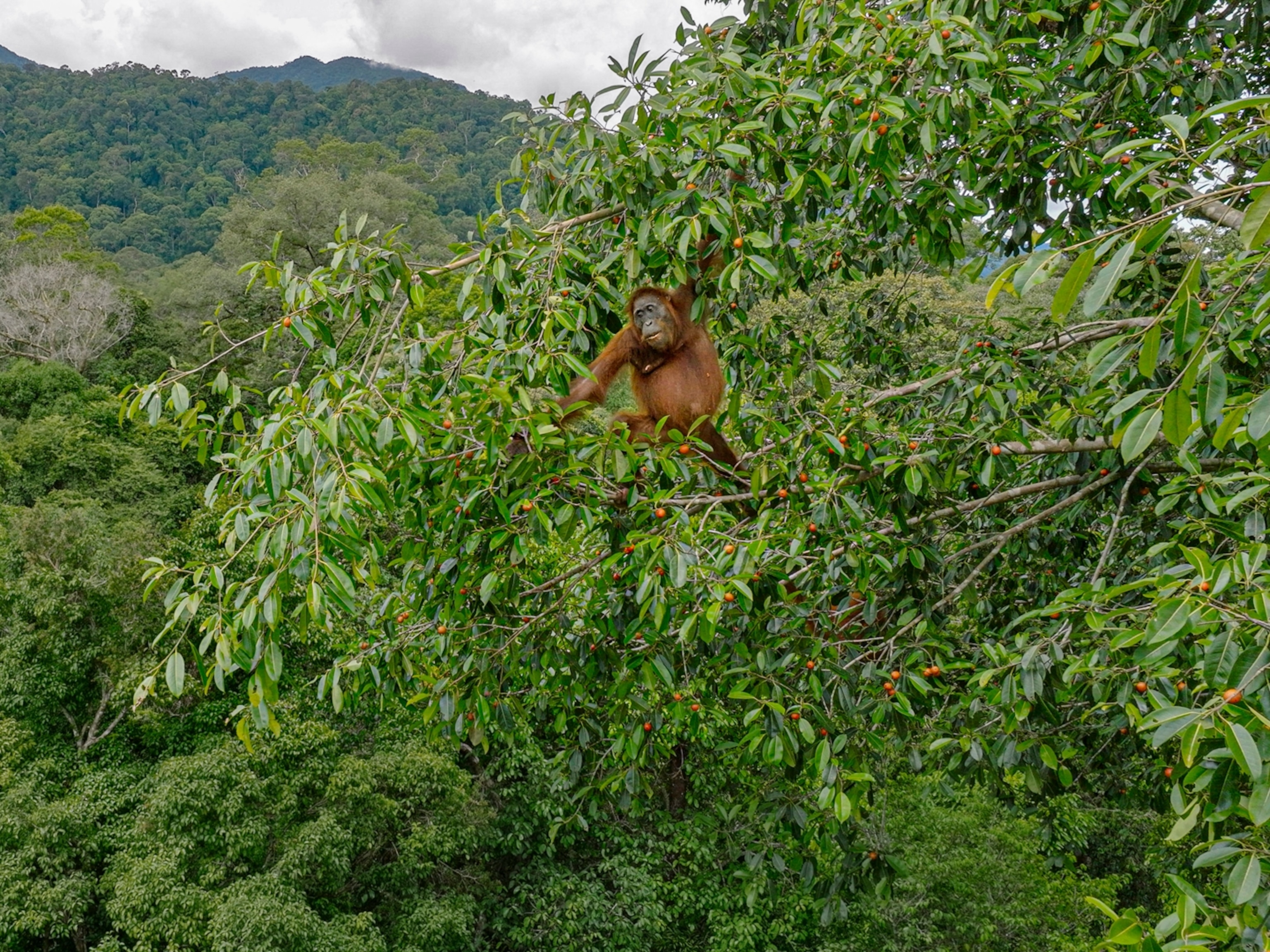
Indigenous people battle squatters and timber poachers in Peru's Amazon
Forest guardians are working to protect their land from a recent rash of new migrants, many of them breaking the law.
Puerto Maldonado, Peru — On March 14, 2018, an alarm sounded in the ears of Jose Vargas, who was sitting at his desk in this Peruvian Amazon city. Embedded in the amber wood of a cedar tree, a small tracking device developed to spring to life at the whir of a chainsaw or crunching of boots on earth sent an alert via satellite to the offices of the Peruvian Society for Environmental Law (SPDA), where Vargas works as a GIS specialist.
Vargas jumped on his phone and called Ruhiler Aguirre, the president of the indigenous community of Infierno. He then called together a small group of lawyers, law enforcement, and indigenous leaders from the south-eastern department of Madre de Dios.
Together, they set out to catch the potential timber poachers felling giants on Infierno land.
Infierno—in translation, literally “Hell”—got its name not from its steamy temperature, but from the scarlet fever that spread through indigenous communities during colonial Spanish expansion. There, the sick threw themselves into the nearby Rio Tambopata to cool their fevers. Their bodies floated to the top. What place could this be, the missionaries wrote, but hell?
Infierno’s population of 600 is part of the Ese’eja indigenous group, which stretches from Peru into Bolivia and a small part of Brazil. It stands out among indigenous communities in Madre de Dios, according to Rosa Baca, the regional director of the local indigenous rights firm FENAMAD based in Puerto Maldonado. The community’s council has been described as “modernized” and “organized” by the local media; they run a successful eco-lodge in association with the international conservation group Rainforest Alliance; and they run a community farm and local artisan shop in the village center, which is lined with colorful bunting. The community benefits from a narrow dirt road that connects it to Puerto Maldonado. It is financially independent and sends its youth to college to learn skills like tour guiding, marketing, and business management.
Although Infierno is more prosperous and integrated into the global economy than many other Amazon towns, it is still struggling with an onslaught of deforestation, much of it driven by illegal logging and timber harvesting. A flood of recent migrants from elsewhere in the region have accelerated pressures on the town’s services and the surrounding forest, setting up conflicts with the local indigenous people that are playing out across much of the Amazon—conflicts many say are heightened by recent actions and rhetoric from Brasilia.
Who owns the land?

In 2006, Infierno was granted 6,000 hectares of land as part of the Peruvian “concession” system. Concessions are land designations granted by the state—some give license for mining or forestry activities, and others are for tourism or conservation. Currently, oil and gas concessions cover about 75 percent of the Peruvian Amazon. Roughly 1,100 square miles of Peru's forests are cut down every year—around 80 percent of them illegally.
The land granted to Infierno was given with two mandates: on one, they run the eco-lodge. The other, 1,600 hectares off the shores of Tres Chimbadas Lake, must be preserved as-is. “Basically, if we lose one foot, it becomes a problem,” says Aguirre. “We take care of this wood in our hands.”
The state’s concessions have not guaranteed that the land is not exploited, however. In the south-eastern department of Madre de Dios in particular, tree poaching has been on the rise. It’s partly a symptom of what forest governance experts call “leakage” as illegal logging is cracked down on in Brazil and poachers respond by crossing the border into Peru. Madre de Dios is heavily influenced by the traffic and trade that flows along the Inter-Oceanic Highway, a roadway more than 1,600 miles long that runs from Peru’s Pacific coast into the Amazon in Brazil.
“A lot of people are coming here because we have this Inter-Oceanic Highway,” says Oscar Mishaja, Infierno’s vice president, sitting at a boardroom table surrounded by Infierno’s council. “[They’re] looking for opportunity to live here or an opportunity to set up a business—like timber extraction or cattle ranches. They can use a small truck and take the wood away to Puerto Maldonado.”
From her office in a bungalow that overlooks the lush river valley of Puerto Maldonado—the capital city of Madre de Dios and a burgeoning tourism hub—Baca sat down to discuss the complexities of conservation and poaching. It’s layers of exploitation and poverty coming from both sides, each attempting to get a hold on life in a developing land.
Baca is quick to note that agricultural immigration and its effects are not entirely environmental or economic. There are also cultural changes at play.
Under cover of darkness
The deep red ochre of the shihuahuaco tree shone between the dark green ferns that line the shores of Tres Chimbadas Lake. Slowly approaching the shore, an Infierno forest guardian named Leo helped us step onto milled shihuahuaco slabs that act as steps onto the forest floor. Resting here for months, these slabs were the first inkling we saw of nine poaching sites within the concession. This plot of land, another 20 miles from Infierno by riverboat, foot, and lake travel, is deep within the Tahuamanu rainforest. It has been targeted by timber poachers acting not on a vast scale, but on a tree-by-tree basis.
In total, Infierno’s council estimates that about 29,000 feet of wood was harvested illegally over a month in 2018. At one point, 52 shihuahuaco stood in this forest. Now, there are 11 fewer.
“They do it basically at night,” says Mishaja. The trees take upwards of 1,000 years to grow. On average, an old-growth tree poached from this area sells for about 3,000 Peruvian Soles, or $1,000 USD.
Infierno’s council built a hut on their concession land to host its forest monitors, who live there alone. At times, those monitors report hearing the whir of chainsaws in the distance. But it can take a week to walk through the concession and approaching who Aguirre dubs “land invaders” is intimidating. To have them removed requires the state’s ecological police to be present at the moment of illegal logging.
Roots of a problem
The socio-economic foundation of today’s Peruvian Amazon was laid during the mid-twentieth century military regime of Juan Velasco, which had adopted a pro-indigenous agenda. In 1974, the state passed legislation that protected the rights of indigenous peoples. Groups earned official recognition from the government and indigenous leaders in the Amazon began forming federations. The regime aimed to break down colonial-style hacienda systems of land management.
But in the interior of Peru this push against imperialism also created problems. Amazonian communities experienced an influx of new visitors, some of whom made blatant land grabs, while the state no longer provided protection. Watching illegal incursions onto their land go unpunished, many indigenous communities developed distrust of the state. In response, Rondas compesinas were formed—community groups that stand guard over land.
A rare bust
For weeks in early 2018, Aguirre worked with SPDA, the local ecological police, the forest guardians, and other indigenous leaders to set in place a plan for the next time logging occurred. So they were prepared, when Vargas heard the chainsaw and SPDA was alerted, and set off on the 40-mile road and boat journey from Puerto Maldonado to catch the loggers in the act.
When they got there, by crossing muddy tracts of land and mosquito-swarmed creeks, Aguirre and team found two men—Luis Cabanillas Loja and Cesar Lenin Cabanillas Isla, a father and son duo—felling trees on the eco-concession land. The men were soon sentenced to 6 months in jail for illegal logging.

During their case it emerged that the men had been hired to remove trees by Rene Estrella Moroco, who Aguirre accused of squatting on Infierno’s eco-concession land since 2002 with his family. According to Aguirre, Estrella Moroco had first requested permission to live on Ese’eja land but was denied. Still, they didn’t budge, even reportedly naming their small farm Elsita. In frustration, Infierno forest monitors once dismantled the Estrella Moroco home and moved their belongings off the concession. Weeks later, they were back.
In July 2018 Estrella Moroco was found guilty of selling the poached wood that Loja and Isla harvested to sellers in Puerto Maldonad. Appearing in court, he argued that he had contracted the men to fell a tree to help repair parts of his house. Yet the government presented evidence showing about 15 hectares of rare, old-growth ironwood trees had been logged off the land. Aguirre says Estrella Moroco and his family no longer live on concession land, but that otherwise he does not believe Estrella Moroco has received an official punishment. (Estrella Moroco and his family could not be reached for comment.)
Many times, the people who actually cut the trees don’t have the whole story. In Puerto Maldonado, there is an agency near the airport that pairs new migrants with employers outside the city. “They don’t know...” says Aguirre. “But they know it’s not legal [when they get there], because the trees haven’t been cut.”
Many of these economic migrants to the Amazon trail behind them the legacy of the Shining Path revolutionary movement in the country’s northern Andes regions. Indigenous peoples often suffered the most at the hands of the violent Shining Path, which has been labeled a terrorist organization—seventy-five percent of their victims were Quechua and many survivors fled south for safety and work in the jungle.. In recent reports, indigenous leaders have noted that “migrants from the Andes will advance into the forest even if there are no roads.”
A global issue
In fact, roads are easy to forge. A wide road had been created using machetes and small tuc-tuc carts from the dock at Tres Chimbadas Lake. It was wide enough to walk down three-abreast, Aguirre and Leo swinging machetes, and ended about two hours later near a makeshift mill and campsite scattered with chainsaw parts and fuel canisters.
Along the way, Aguirre and his forest monitors duck behind stands of trees—estoraque, moena, cedrelinga, huimba—to showcase the stumps left behind. In each case, leftover slices of trunk towered in stacks surrounded by piles of sawdust and planks of milled, smooth wood. Sometimes, the wood had been “hidden” by piles of leaves and dried palms. The scale was beyond what I expected—just steps off this makeshift path, acres of destroyed forest. Chunks of wood were splayed on the ground, and we sat on them for a break from the heat.
Peru is the fourth-largest rainforest country in the world, and its trees make up part of the root and canopy system that act as the world’s lungs. Since 2012, deforestation rates have increased in Peru, largely due to the economic growth fostered by industries like large-scale agriculture and mining, which require trees to be cleared. Still, it’s estimated that three-quarters of all of Peru’s timber exports are logged illegally. Much of this goes to the United States in the form of furniture, parquet flooring, and decks.
It’s a large-scale, globalized problem, but its true effects are witnessed in the everyday lives of those that live in these areas. Loggers, for instance, take one tree at a time. Forest guardians struggle to find cell phone coverage to report them in a timely manner. Loggers also hunt for food while they work, and guardians note they find it harder to find species to hunt themselves. Through many of the oral histories I collected there, it’s not so much the trees that act as a spiritual conduit, but what the tree ushers in: shelter, food, animals. “They were nomadic, they used to walk from one side to another,” says Mishaja of his ancestors’ relationships with timber.
“They can feel different things, more special things,” adds Aguirre. “But people from outside the community, they feel different for the forest. They don’t care. So they sell.”
Here, indigenous communities work to preserve their forest lands as a mode of self-preservation but are confronted with the environmental realities that accompany societal change in other regions. The face of deforestation is not a globalized economy, high-end demand or multinational corporations, but instead the poor that see no choice but to poach. “The easy way to get money is the illegal way,” says Aguirre.
Milton López-Tarabochia contributed translating and research to this story
You May Also Like
Go Further
Animals
- Octopuses have a lot of secrets. Can you guess 8 of them?
- Animals
- Feature
Octopuses have a lot of secrets. Can you guess 8 of them? - This biologist and her rescue dog help protect bears in the AndesThis biologist and her rescue dog help protect bears in the Andes
- An octopus invited this writer into her tank—and her secret worldAn octopus invited this writer into her tank—and her secret world
- Peace-loving bonobos are more aggressive than we thoughtPeace-loving bonobos are more aggressive than we thought
Environment
- Listen to 30 years of climate change transformed into haunting musicListen to 30 years of climate change transformed into haunting music
- This ancient society tried to stop El Niño—with child sacrificeThis ancient society tried to stop El Niño—with child sacrifice
- U.S. plans to clean its drinking water. What does that mean?U.S. plans to clean its drinking water. What does that mean?
- Food systems: supporting the triangle of food security, Video Story
- Paid Content
Food systems: supporting the triangle of food security - Will we ever solve the mystery of the Mima mounds?Will we ever solve the mystery of the Mima mounds?
History & Culture
- Strange clues in a Maya temple reveal a fiery political dramaStrange clues in a Maya temple reveal a fiery political drama
- How technology is revealing secrets in these ancient scrollsHow technology is revealing secrets in these ancient scrolls
- Pilgrimages aren’t just spiritual anymore. They’re a workout.Pilgrimages aren’t just spiritual anymore. They’re a workout.
- This ancient society tried to stop El Niño—with child sacrificeThis ancient society tried to stop El Niño—with child sacrifice
- This ancient cure was just revived in a lab. Does it work?This ancient cure was just revived in a lab. Does it work?
Science
- The unexpected health benefits of Ozempic and MounjaroThe unexpected health benefits of Ozempic and Mounjaro
- Do you have an inner monologue? Here’s what it reveals about you.Do you have an inner monologue? Here’s what it reveals about you.
- Jupiter’s volcanic moon Io has been erupting for billions of yearsJupiter’s volcanic moon Io has been erupting for billions of years
- This 80-foot-long sea monster was the killer whale of its timeThis 80-foot-long sea monster was the killer whale of its time
Travel
- How to plan an epic summer trip to a national parkHow to plan an epic summer trip to a national park
- This town is the Alps' first European Capital of CultureThis town is the Alps' first European Capital of Culture
- This royal city lies in the shadow of Kuala LumpurThis royal city lies in the shadow of Kuala Lumpur
- This author tells the story of crypto-trading Mongolian nomadsThis author tells the story of crypto-trading Mongolian nomads







